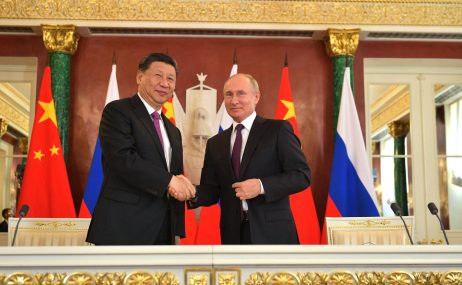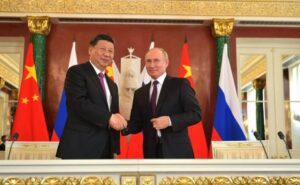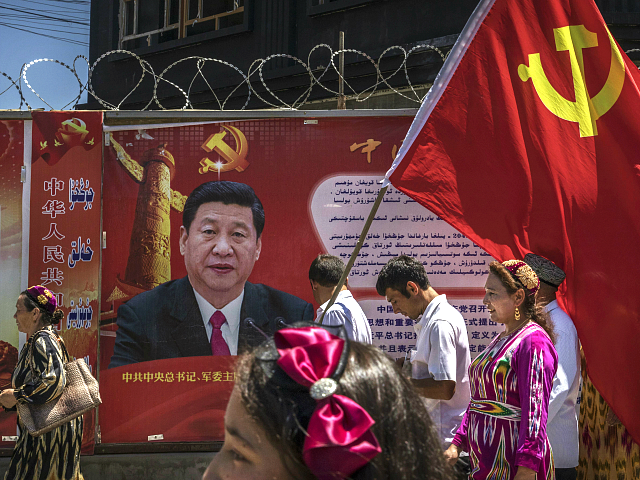Sino-Russian Economic Cooperation in Central Asia is Not What It Seems to Be

Sept 25-
Sino-Russian Economic Cooperation in Central Asia is Not What It Seems to Be
China and Russia are partners in Central Asia, but their cooperative efforts are not as robust as they often claim.
When China-Central Asia relations were in their nascent stages, Russia and China planned for a cooperative and mutually beneficial partnership in the region. For many years, the two countries continued to perform their tacitly agreed roles, with China providing the funds for economic development and Russia maintaining a favorable political climate and keeping tabs on regional military affairs. In recent years, however, Beijing has expanded its economic influence in the region into other sectors. For Central Asia’s oldest partner, Russia, undue Chinese influence in the region could jeopardize its political clout.
The more Russia felt threatened by China’s economic influence, the further it looked for opportunities for cooperation, starting with the Belt and Road Initiative. But the burgeoning economic ties between Central Asia and China are not tantamount to fading Russian influence in the region. Contrary to what is projected, Sino-Russian cooperation has neither yielded huge benefits, nor have the two been able to wield a massive amount of economic leverage single-handedly.
Take the Eurasian Economic Union (EAEU) and the Belt and Road Initiative (BRI). As far as the BRI is concerned, Russia is an enthusiastic partner so long as it does not surpass the EAEU, of which Kazakhstan and Kyrgyzstan are both also members. However, Russia-China economic cooperation in Central Asia has not been as optimistic as it is often portrayed to be. For instance, China’s outright refusal to take up even one out of the 40 transportation projects put forward by the EAEU has soured Russia’s attitude. In the high-level video conference held on Belt and Road cooperation in July, the Russian foreign minister was conspicuously absent.
No doubt it has come to Russia as a blinding revelation that deeper relations in terms of the BRI will likely lead to an unequal partnership in which China has the upper hand. In fact, the relationship of convenience between Beijing and Moscow is complicating the economic landscape in Central Asia.
For Russia, the easiest option is to position India as a counterweight to China – a strategy Russia has employed in the past by actively pushing for India’s membership in the Shanghai Cooperation Organization (SCO). The fact is that India can achieve its economic and connectivity goals outside the SCO framework by engaging bilaterally while also bypassing Pakistan and China. The Chabahar port project and India’s accession to the Ashgabat Agreement are two key achievements in that regard. Moreover, any attempt to involve India as an equipoise to China will elicit the most obvious response from Beijing: inviting Pakistan to play a balancing role. China did just that by pulling Pakistan into the SCO in tandem with India.
That, however, does not allow Beijing to be reckless. Against a backdrop of growing discontent with the BRI, China cannot risk having Russia turn its back on the initiative. Its goals are still constrained by Russia’s deep-rooted relations with Central Asia. For now, China is careful not to overstep these boundaries, limiting itself to economic goals without explicitly involving itself in the region’s political affairs. To an extent, this has worked well for Beijing. In a way, the very absence of a political agenda thus far also sets China’s Central Asian strategy apart from Russia’s. Behind every move to integrate economically and culturally through organizations such as the EAEU is Russia’s larger goal to consolidate political power in the region. As this strategy becomes ever more clear, China has adjusted its strategy bilaterally instead of pursuing a collective policy like Russia.
On the surface, it appears as though the balance of economic cooperation lies on China’s side. But that’s not necessarily the case. The economic dynamics between Russia, China and Central Asia are predominantly studied only through the lens of Russian and Chinese interests – Central Asian interests are often left out. But nevertheless, their interactions are slowly being shaped by the Central Asian governments and the growing voice of the public.
In the case of Central Asian governments, the goal is to maintain a balance between Russia and China. With no other dominant player who can offer economic assistance that is conducive to the generally autocratic political climate, it is too risky to pick one over the other. Take Uzbekistan as an example. China is its largest foreign investor. Between 1992 and 2017, Chinese investments in the region totaled $8 billion. But that hasn’t stopped Uzbekistan from pursuing opportunities for trade and infrastructure development with Russia. Three months ago, the country announced its entry into the EAEU as an observer, although the benefits of that choice are highly uncertain. Turkmenistan has followed a similar path. Following Russia’s termination of natural gas purchases from Turkmenistan in 2016, nearly 80 percent of its gas exports went to China. In 2019, Turkmenistan and Russia resumed their trade in natural gas after nearly three years, but the total volume remains small.
Public opinion, on the other hand, contrasts starkly with the Sinophilia of Central Asian governments. In Kazakhstan, protesters have opposed the presence of Chinese factories that are planned as part of an initiative to create local jobs and increase investment. The public’s concerns were two-fold. First, that China was turning Kazakhstan into a dumping ground for polluting Chinese manufacturing plants. Second, that only a few locals were given jobs, as the Chinese companies implementing many of the projects brought Chinese workers along with them. Citizens in these countries fear that their leaders will gradually exchange local jobs and citizen privacy for lucrative investments.
As a result, China is facing a serious trust deficit in Central Asia, which has been further magnified by Russia’s favorable and unrivaled public support from the region and its overwhelming media presence. A recent Wilson Center survey revealed that China lags woefully behind Russia when it comes to public opinion regarding closer economic relations. In Kazakhstan and Kyrgyzstan, a stark difference in public perception toward China and Russia can be observed. Only in Turkmenistan and Uzbekistan does China enjoy relatively positive public opinion. These two countries also happen to be the ones that do not share borders with China. For Kazakhstan, Kyrgyzstan and Tajikistan, concerns about landgrabs by China feed negative public opinion, in addition to other issues.
For now, it is possible to affirm two things. First, that China’s partnership with Russia in Central Asia is not as robust as it is claimed to be. The uneven economic strengths of the two powers might not necessarily produce a rivalry between the two, but it does slow the development of joint projects.
Second, contrary to popular opinion, there is unlikely to be a single winner in Central Asia’s great game. In most cases, China’s growing economic ties with Central Asia belies the region’s effort to avoid excessive reliance on any one country. The future of Sino-Russian economic cooperation in the region will no longer be limited to Russian and Chinese interests alone. The broader dynamics of their triangular economic relations will see vast changes in a post-pandemic world.
Varshini Sridhar graduated with a bachelor of arts in economics, political science and sociology from Christ University. She is currently working as a project assistant at the Centre for Public Policy Research after valuable internship stints at NITI Aayog, PricewaterhouseCoopers and Janaagraha. Varshini has previously been published at the International Policy Digest and The Geopolitics and frequently writes for Polemics and Pedantics.
Courtesy: The Diplomat: https://thediplomat.com/2020/09/sino-russian-economic-cooperation-in-central-asia-is-not-what-it-seems-to-be/



